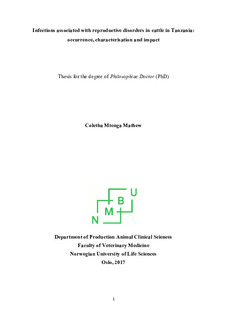| dc.description.abstract | The livestock sector in Tanzania is huge in animal numbers but the production is disproportionally small. Most of the infections known to cause reproductive disorders are generally regarded endemic in Africa, but more specific information is lacking. The overall aim of the study was therefore to investigate the occurrence, characteristics, and impact of selected infections causing reproductive disorders in cattle in Tanzania.
A cross-sectional study was performed in two locations in Njombe and Mbeya regions in the southern highlands of Tanzania. In total, 202 cattle herds were visited once, and relevant information and biodata were collected through direct observation and interview of farmers. Biomaterials from 658 animals were collected for laboratory analysis.
The most common reproductive disorders encountered in the area were abortion (11.3%) and retained placenta (17.2%) (Paper 1). Antibodies specific to bovine viral diarrhoea virus (BVDV) were found in 15.2% of the animals in 17.9% of the herds, and antibodies to Brucella spp. in 5.4% of the animals in 7.4% of the herds. Herd level seroprevalence varied considerably between the two locations, from 6.5% to 66.7% for BVDV and from 0.6% to 36.1% for Brucella spp. A regression model identified large herds (odds ratio (OR): 14.5), location (OR: 23.1) and grazing (OR: 22.7) as risk factors for Brucella seropositivity and location (OR: 12.7) as risk factor for BVDV seropositivity at herd level. Brucella (OR: 15.5) and BVDV (OR: 5.0) seropositivity was associated with abortion at herd level. N. caninum-specific antibodies were found in 4.5% of animals and in 8.4% of the herds but no associations with reproductive disorders nor risk factors were found.
Brucellosis was further studied in one of the herds, which was experiencing abortions (Paper 2). The within-herd seroprevalence in cattle (n = 200) was 48% (95% CI 41-55), using an indirect antibody ELISA. Three Brucella isolates were cultured from an aborted foetus and associated foetal membranes. A multiplex PCR (Bruce-ladder), 16s rDNA gene sequencing and classical biotyping classified the isolates as B. abortus biovar 3. A multiple locus variable number of tandem repeats analysis (MLVA-16) revealed two different but closely related genotypes. High within-herd prevalence, isolation of the pathogen, and abortion confirm that B. abortus is circulating in this herd with cattle as reservoir hosts.
In Paper 3, sera from all cattle were analyzed using an antibody ELISA kit for Schmallenberg virus (SBV), and 61% were positive. SBV virus neutralization test (VNT) was then performed on 110 sera collected, of which 51 % were positive. Additional sera from the same area collected in 2008/2009were then included and 54.6% were positive in the antibody ELISA while 21% were positive in the VNT.45 ELISA positive sera were further analysed in VNTs for the related viruses Akabane, Douglas, Peaton, Sabo, SBV, Sathuperi, Shamonda, Aino, Tinaroo and Simbu viruses. Antibodies to all except Simbu virus were detected. For SBV, 29 sera (64.4%) were positive. These results indicate that SBV or a closely related virus was present in Tanzania before the European epidemic, however, cross-reactivity complicates the interpretation of serological studies.
Overall, the study shows that the selected infections represent both animal and human health risks in the study area. Two new genotypes of B. abortus that are not related to other African strains and antibodies to eight new Simbu serogroup viruses in Tanzania, of which four are also new to Africa, were found. The highly variable prevalence and impact of Brucella spp. and BVDV infections between geographically closely related locations require awareness. Animal contact represents a serious risk of introducing infections to infection-free sub-populations, and changes in management factors might alter conditions for spread and survival within the subgroups. Unpasteurised milk is commonly consumed in the area which underscores the need for strategic ‘One health’ control measures. | nb_NO |

